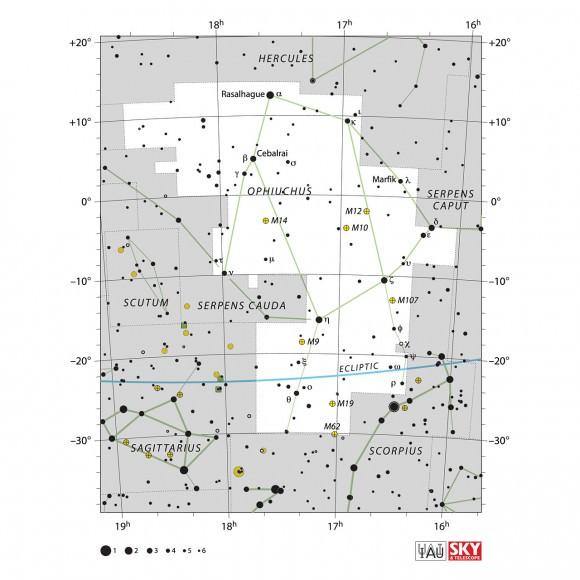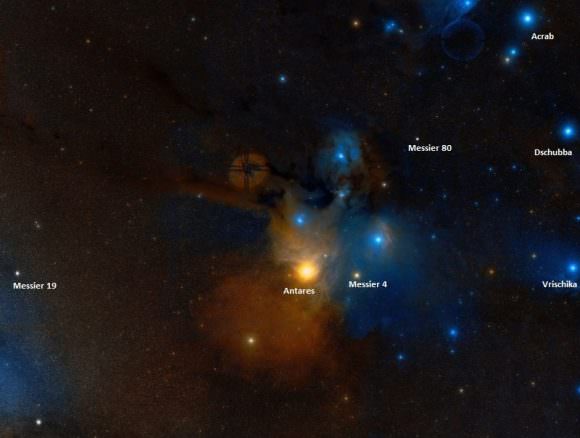Welcome back to Messier Monday! In our ongoing tribute to the great Tammy Plotner, we take a look at the Messier 19 globular star cluster. Enjoy!
In the 18th century, while searching the night sky for comets, French astronomer Charles Messier began noticing a series of “nebulous objects” in the night sky. Hoping to ensure that other astronomers did not make the same mistake, he began compiling a list of these objects,. Known to posterity as the Messier Catalog, this list has come to be one of the most important milestones in the research of Deep Sky objects.
One of these objects is Messier 19, a globular star cluster located in the constellation Ophiuchus. Of all the known globular clusters, M19 appears to be one of the most oblate (i.e. flattest) in the night sky. Discovered by William Herschel, this cluster is relatively difficult to spot with the naked eye, and appears as a fuzzy point of light with the help of magnification.
Description:
Speeding away from us at a rate of 146 kilometers per second, this gravitationally bound ball of stars measuring 140 light years in diameter, is one of the Messier globular clusters that has the distinction of being closest to the center of the Milky Way. At a little more than 5000 light-years from the intense gravitation of our own galactic core, it has played havoc on M19’s round shape.
In essence, Milky Way’s gravity has caused M19 to become one of the most oblate of all globular clusters, with twice as many stars along the major axis as along the minor. And, although it is 28,000 light-years from Earth, it’s actually on the opposite side of the galactic core. For all of its rich, dense mass, four RR Lyrae variable stars have been found in M19.

Is Messier 19 unique? It has some stellar branch properties that are difficult to pinpoint. And even its age (though estimated at around 11.9 billion years old) is indeterminate. Says F. Meissner and A. Weiss in their 2006 study, “Global fitting of globular cluster age indicators“:
“The determination of globular cluster (GC) ages rests on the fact that colour-magnitude diagrams (CMDs) of single-age single composition stellar populations exhibit specific time-dependent features. Most importantly, this is the location of the turn-off (TO), which – together with the cluster’s distance – serves as the most straightforward and widely used age indicator. However, there are other parts of the CMD that change their colour or brightness with age, too. Since the sensitivity to time is different for the various parts of the cluster CMD, it is possible to use either the various indicators independently, or the differences in colour and brightness between pairs of them; these latter methods have the advantage of being independent of distance.”
What’s occurring is a horizontal branch gap – an not-quite explainable difference in the way the stars inside M19 are aging. However, science is looking for the answer. As G. Busso et al. explained in their 2008 paper titled “The Peculiar Horizontal Branch Morphology of the Galactic Globular Clusters NGC 6388 and NGC 6441“:
“I show that a possible solution of the puzzle is to assume that a small fraction of the stellar population in the two clusters is strongly helium enriched. The presence of two distinct stellar populations characterized by two different initial He contents can help in explaining the brightness difference between the red portion of the HB and the blue component.”

Is helium the answer? Quite probably so. M. Salaris Astrophysics Research Institute and an international team of researchers explained in their 2004 study “The initial helium abundance of the Galactic globular cluster system“:
“Based on a recently updated set of stellar evolution models, we performed an accurate statistical analysis in order to assess whether GGCs show a statistically significant spread in their initial He abundances, and whether there is a correlation with the cluster metallicity. As in previous works on the subject, we do not find any significant dependence of the He abundance on the cluster metallicity; this provides an important constraint for models of Galaxy formation and evolution. Apart from GGCs with the bluest Horizontal Branch morphology, the observed spread in the individual helium abundances is statistically compatible with the individual errors. This means that either there is no intrinsic abundance spread among the GGCs, or that this is masked by the errors. In the latter case we have estimated a firm upper limit of 0.019 to the possible intrinsic spread. In case of the GGCs with the bluest Horizontal Branch morphology we detect a significant spread towards higher abundances inconsistent with the individual errors; this can be fully explained by additional effects not accounted for in our theoretical calibrations, which do not affect the abundances estimated for the clusters with redder Horizontal Branch morphology.”
History of Observation:
M19 was one of Charles Messier’s original discoveries, which he first observed on June 5th, 1764. In his notes, he wrote:
“I have discovered a nebula, situated on the parallel of Antares, between Scorpius and the right foot of Ophiuchus: that nebula is round & doesn’t contain any star; I have examined it with a Gregorian telescope which magnified 104 times, it is about 3 minutes of arc in diameter: one sees it very well with an ordinary refractor of 3 feet and a half. I have observed its passage of the Medirian, and compared it with that of the star Antares; I have determined the right ascension of that nebula of 252d 1′ 45″, and its declination of 25d 54′ 46″ south. The known star closest to that nebula is the 28th of the constellation Ophiuchus, after the catalog of Flamsteed, of sixth magnitude.”

While Charles didn’t resolve it, we must give him due credit for discovery, for its size wouldn’t make it a particularly easy object given his optics. Later, in 1784, William Herschel would become the first to open up its true identity:
“When the 19th of the Connoiss. is viewed with a magnifying power of 120, the stars are visible; the cluster is insulated; some of the small stars scattered in the neighborhood are near it; but they are larger than those belonging to the cluster. With 240 it is better resolved, and is much condensed in the centre. With 300 no nucleus or central body can be seen. The diameter with the 10 feet is 3’16”, and the stars in the centre are too accumulated to be separately seen. It will not be necessary to add that the two last mentioned globular clusters, viewed with more powerful instruments, are of equal beauty with the rest; and from what has been said it is obvious that here the exertion of a clustering power has brought the accumulation and artificial construction of these wonderful celestial objects to the highest degree of mysterious perfection.”
While you may – or may not – resolve Messier 19’s individual stars, even small telescopes can pick up on some of its ellipticity and larger telescopes will make out a definite blue tinge to its coloration. Before you yawn at viewing another globular cluster, remember that you are looking at the other side of our galactic center and think on the words about M19 from Admiral Symth.
“The whole vicinity,” he wrote, “afford a grand conception of the grandeur and richness even of the exterior creation; and indicate the beautious gradation and variety of the heaven of heavens. Truly has it been said, “Stars teach us as well as shine.” This is near the large opening or hole, about 4deg broad, in the Scorpion’s body, which WH [William Herschel] found almost destitute of stars.”

Locating Messier 19:
Finding M19’s location in binoculars is quite easy – it’s less than a fistwidth (8 degrees) east of Antares (Alpha Scorpi). However, ‘seeing’ M19 in binoculars (especially smaller ones) is a little more problematic. The steadier the binoculars are, the better your chances, since it will appear almost stellar at first glance. A good indicator is to have optical double 26 Ophiuchi in the field at the 2:00 position and look for the star that won’t quite come to focus in the 8:00 position.
Star 26 also makes for a great finderscope lead when locating M19 in a telescope as well. Even for aperture sizes as small as 114mm, this globular cluster will show quite easily in a telescope and reveal its oblate nature. When aperture size increase to the 8″ range, it will begin resolution and as it nears 12″ or more, you’ll pick up on blue stars.
And for your convenience, here are the quick facts of M19:
Object Name: Messier 19
Alternative Designations: M19, NGC 6273
Object Type: Class VIII Globular Star Cluster
Constellation: Ophiuchus
Right Ascension: 17 : 02.6 (h:m)
Declination: -26 : 16 (deg:m)
Distance: 28.0 (kly)
Visual Brightness: 6.8 (mag)
Apparent Dimension: 17.0 (arc min)
We have written many interesting articles about Messier Objects here at Universe Today. Here’s Tammy Plotner’s Introduction to the Messier Objects, , M1 – The Crab Nebula, M8 – The Lagoon Nebula, and David Dickison’s articles on the 2013 and 2014 Messier Marathons.
Be to sure to check out our complete Messier Catalog. And for more information, check out the SEDS Messier Database.

